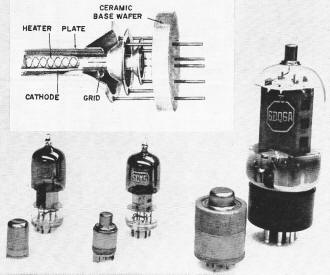|
May 1959 Electronics World
 Table of Contents
Table of Contents
Wax nostalgic about and learn from the history of early electronics. See articles
from
Electronics World, published May 1959
- December 1971. All copyrights hereby acknowledged.
|
The
RCA Nuvistor was
a godsend to hardline vacuum tube lovers who were steadfast members of the Never
Transistor movement of the 1950s and 1960s. It would hopefully be the miracle
invention to obviate the need for replacing tubes with transistors. Of course
everyone knew that vacuum tubes would forever be needed for medium and high power
applications. Solid state semiconductors could never replace cathode ray tubes (CRTs)
for displays or thyratrons for over-the-horizon and commercial broadcast transmitter
amplifiers, so why bother with transistors at all? OK, maybe the emotion wasn't that
severe, but if you read enough articles from vintage magazines of the
tube-to-transistor transition era, you will know that there was a very strong
resistance. History ultimately decided the winner. As a vintage electronics
renaissance guy myself, I love the orange glow of my vacuum tube radio, but also
appreciate the convenience and superior performance of modern electronics.
Tiny Vacuum Tube Rivals Transistor

Three of the new tubes now under development. are shown below along
with their larger present-day counterparts. Inset shows inside construction of the triode.
The outer shell, or envelope, of the new tube is metal or metal and a ceramic.
High-efficiency, thimble-sized electron tubes are made possible by new RCA Nuvistor
design.
A new development in vacuum-tube construction techniques that will serve to make the
tube more competitive with the transistor was demonstrated recently by RCA. In moderate
to high power uses and especially at higher frequencies, tubes made with the technique
are expected to far outshine their transistor counterparts. What is more, the new construction
is well suited to mass production and the finished tubes are far more rugged, reliable,
and efficient than ordinary tubes. Many notions about tube construction were abandoned
and the construction of the new tubes was based on a fresh design approach, both from
the mechanical and electrical points of view.
Called "Nuvistors," the new tubes may find wide use in television receivers, communications
receivers, and computers, as well as in more compact and efficient electronic equipment
for defense and industry. Prototypes of the new tubes are now in advanced development
at RCA's Electron Tube Division in Harrison, N. J. Developmental samples of the "new
look" tubes are now being furnished to the electronics industry. A small-signal triode
and a small-signal tetrode are offered at first and these will be followed later by a
beam-power tube. According to present plans, limited commercial production will be started
in 1960.
At the press demonstrations, a completely "nuvistorized" tuner unit of a television
set was shown in operation. The tuner required only a fraction of the plate voltage needed
by conventional tuners. This experimental tuner, believed to be among the smallest ever
designed for "TV receivers, reduces the over-all volume of conventional tube TV tuner
units by approximately one-third.
The ruggedness of the new design was displayed in several torture and endurance tests.
The tiny tube continued to function normally in an electronic circuit when placed alternately
in the heating coils of a special furnace (at 660 degrees F) and in liquid nitrogen (at
-320 degrees F). In another demonstration, the new tubes were shown operating continuously
in both the special furnace and in liquid nitrogen. Operation of the tubes was also not
disturbed as the tubes were dropped repeatedly onto a metal block from a height of several
feet. A cathode-ray tube curve tracer connected to the tube being dropped showed absolutely
no change in operation and performance when the tube bounced on the block. The demonstrations
clearly showed the high temperature capabilities of the "Nuvistors" as well as their
reliable performance under conditions of severe shock and continuous vibration.
Although life testing has not as yet been completed, it was said that tubes of this
new design should have useful lives of tens or even hundreds of thousands of hours of
normal operation.
Posted July 11, 2018
|




























